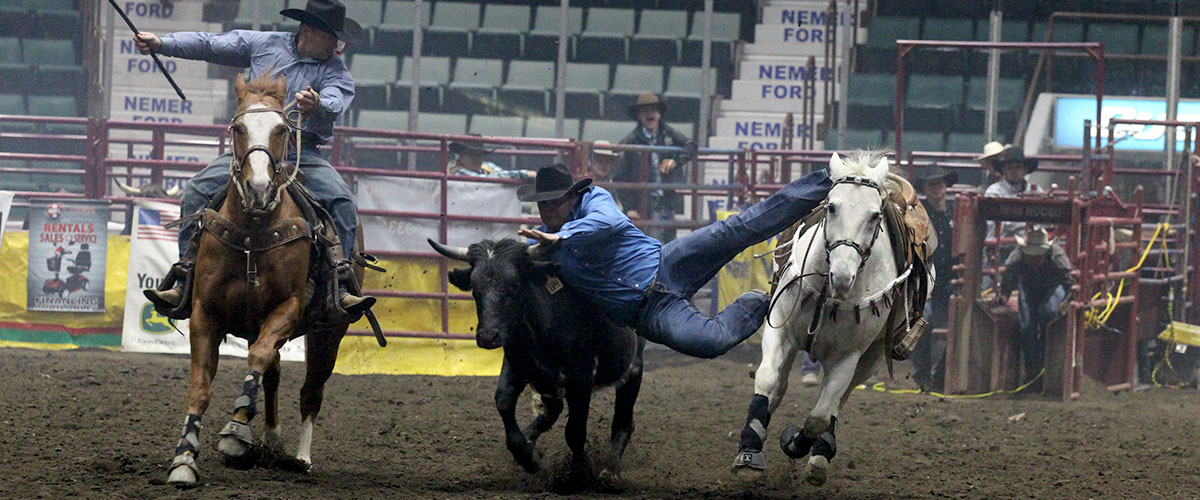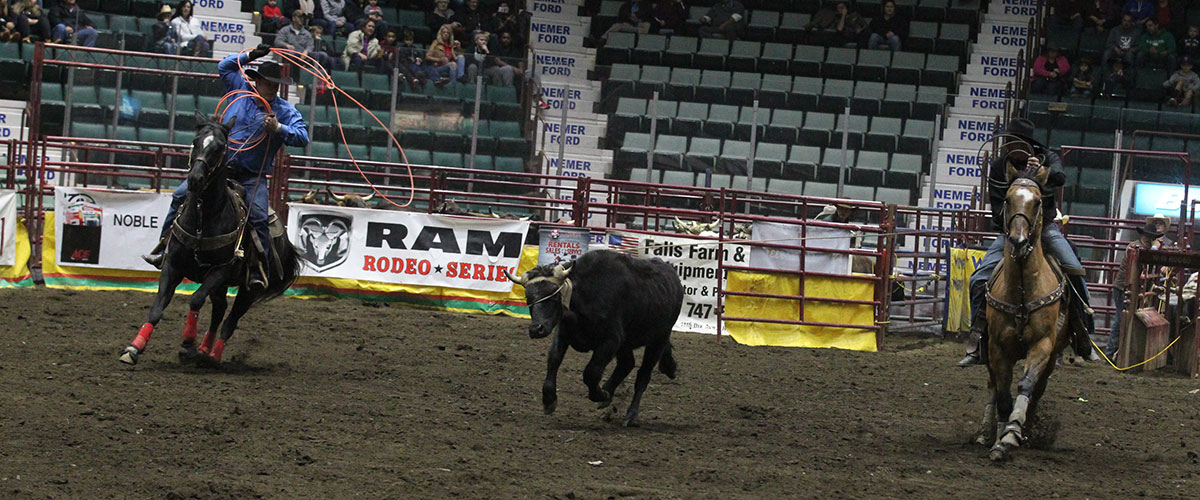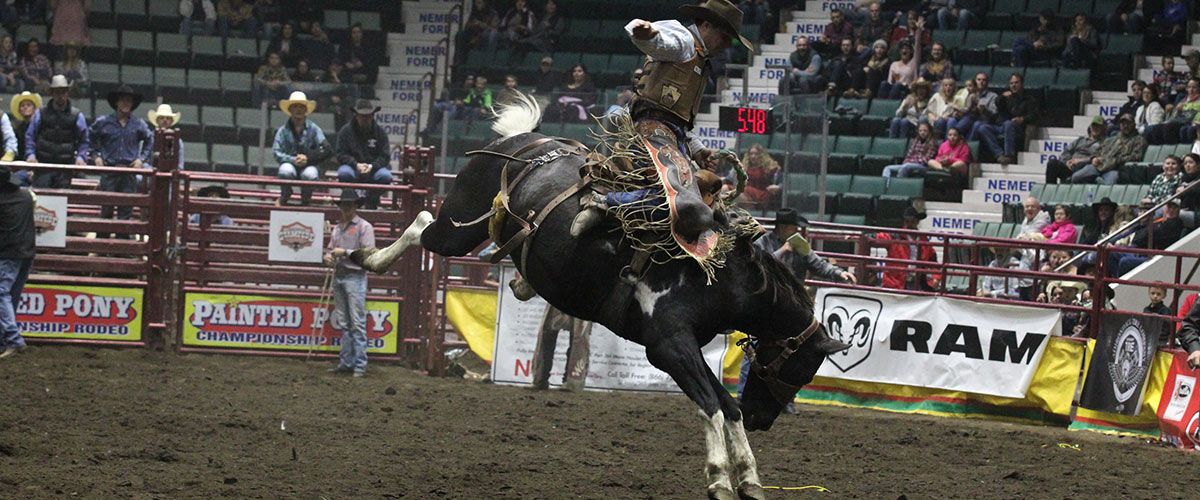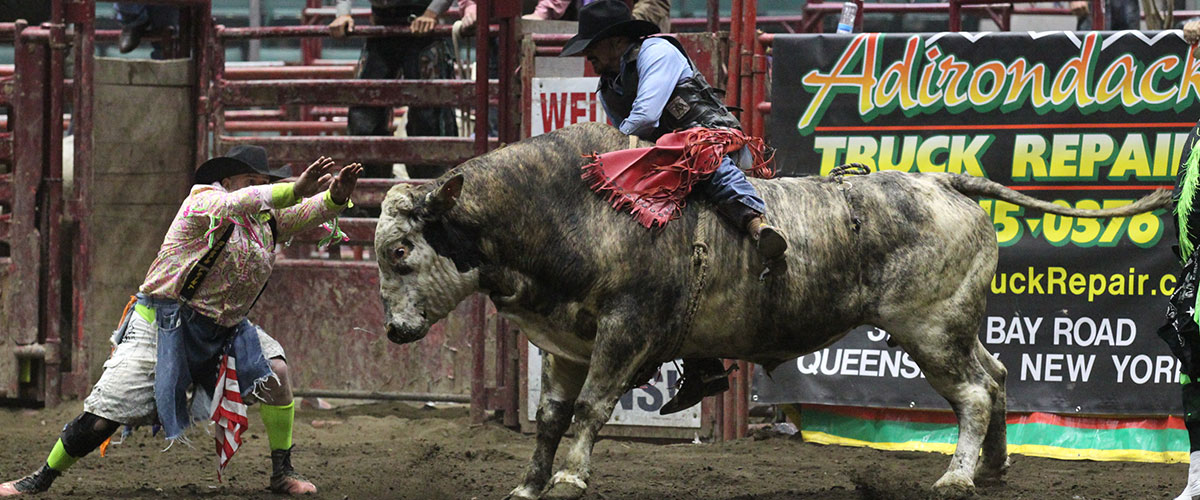Rodeo Events
Bareback Riding

It’s one bumpy ride from start to finish.
An event developed in the rodeo arena, bareback riding produces some of the wildest action seen in sports today.
The bareback rider is judged on his spurring technique, the degree to which his toes remain turned away from the horse throughout the ride and his "exposure," or willingness to lean far back and take whatever may come during the ride. The horse’s bucking action also contributes to half of a rider’s score.
Bareback riders grasp a "rigging," a handhold made of leather and rawhide that is secured to the horse with a cinch. The rigging must meet size and design specifications set by the PRCA.
Bareback riding also requires the rider to “mark out” his horse – to place his feet above the horse’s shoulders until the animal’s front feet hit the ground on its first move out of the chute. Failure by the cowboy to keep his feet in place results in disqualification.
After the initial jump out of the chute, the cowboy pulls his spurs up the horse’s neck and shoulders until the spurs are nearly touching the rigging. The rider then straightens his legs, again placing his feet on the horse’s shoulders, in anticipation of the next jump.
Scoring
The score is derived from how hard the horse bucks and how well the cowboy spurs and maintains control during the ride.
Steer Wrestling

Strength, timing and balance are the key to bulldogging.
The objective of steer wrestling is evident in its name: to wrestle a steer to the ground using only leverage. The steer wrestler, or "bulldogger", begins his run behind a barrier along with his "hazer", a second cowboy whose task is to keep the steer from veering away from the steer wrestler.
A steer is given a head start, the length of which varies depending on the size of the arena. After the steer has reached the "scoreline" and the barrier is released, the steer wrestler and hazer chase the steer on their specially trained American Quarter Horses until the bulldogger is in position to dismount onto the racing steer.
The steer wrestler slides down the right side of his horse until he can reach the steer’s right horn and grasps the left horn in his left hand, then digs his heels deep in the dirt and uses leverage to bring down the steer.
All this occurs in 3 to 5 seconds, depending on the size of the arena.
In addition to sheer strength, timing and balance are important to the steer wrestler.
Team Roping

Headers, heelers and horses have to be well coordinated.
Equally important in team roping are the talents of the header and the heeler. Most team ropers specialize, although some work alternately as a header or a heeler.
The steer is given a head start based on the size of the arena. The header waits behind a barrier, which is released after the steer has taken the proper head start. If the header breaks the barrier, the team is given a ten-second penalty. The heeler follows after the header has started his pursuit.
The header is the first to rope. He must catch the steer around the horns, around one horn and head or around the neck. His roping job completed, the header dallies the rope around his saddle horn and rides to the left, turning the steer away from the heeler.
As the header rides away, the heeler ropes the steer’s hind feet. Catching only one foot results in a five-second penalty.
The clock is stopped when no slack is in the rope or the ropers are facing each other.
Horses are trained separately for their specialties, heading or heeling. Heading horses usually are taller and heavier then heeling horses because they must turn the steer after the header has made his catch. Heeling horses are quick and agile because they must be able to keep up with the steer’s every move. The horse of choice for either specialty is the American Quarter Horse.
Team roping originated on ranches when a large steer had to be caught and treated or branded. It is still a common practice.
Saddle Bronc Riding

Ranch hands gathered to see who could ride wild horses with the most style.
Considered rodeo’s "classic" event, saddle bronc riding evolved from the ranch work of breaking and training horses.
A saddle bronc rider’s feet must touch the horse’s shoulders on the first jump out of the chute. This is called the "mark-out," and a contestant who fails to have his feet in place at the beginning of the ride is said to have "missed the mark" and is disqualified. He will receive a "no score" for the round.
The rider, gripping a thick rein attached to the horse’s halter, attempts to place his feet over the horse’s shoulders a split second before the animal’s front feet strike the ground. As the horse bucks, the rider bends his front knees and finishes his spurring stroke with his spurs near the "cantle," the back of the saddle, then snaps his feet back to the horse’s shoulders as the animal’s front feet hit the ground. The rider strives to keep his toes turned out during the entire ride.
SCORING
A saddle bronc ride is judged on the cowboy’s spurring action, his control of the horse, and the degree to which his toes are turned out. The horse’s bucking efforts also contribute to the score. An eight second ride is required.
Good scores in this event are earned by the continuous spurring action and the length of stroke.
Better riders use the buckrein for balance, not to help hold themselves on the horse.
Tie Down Roping
Dates back to the Old West more so than any other rodeo event.
Tie down roping’s roots date back to the Old West more so than any other rodeo event. When a calf was sick or injured, it had to be caught and immobilized quickly for treatment. Ranch hands prided themselves on how fast they could rope and tie calves, and they soon began informal contests.
After giving the calf a predesignated head start, the horse and rider give chase. As the cowboy throws his loop, the horse comes to a stop.
After catching the calf, the cowboy dismounts, runs to the calf, throws it to the ground by hand (called "flanking") and ties any three legs together using a "pigging string" he has carried in his teeth throughout the run. While the contestant is accomplishing all of this, the horse must keep slack out of the rope, but not pull it tight enough to drag the calf.
If the calf is not standing when the rope reaches it, the cowboy must allow the calf to stand and then flank it before making the tie.
When the roper has completed his tie, he throws his hands in the air as a signal to the timers. He then remounts his horse and rides toward the calf, making the rope slack. The calf must remain tied for six seconds after the rope is slack or the cowboy will receive a "no time".
Barrel Racing

Equine athletes and their skilled riders perform at their best.
Barrel racing is one of Professional Rodeo’s most colorful and exciting events. This fast-paced contest teaming horse and rider is easy to understand, just like a horse race and often ranks just behind Bull Riding in crowd popularity.
From the grandstands, the event seems simple: horse and rider cross the start line at a run, follow a cloverleaf pattern around three barrels, then dash across the finish line. What is not seen are the years of practice required to train that horse to run the barrels. The times of top riders are so close that electronic timing devices accurate to the hundredth of a second must be used in scoring.
The horse and rider to complete the run the fastest, with no faults, wins the event. Each barrel knocked over is considered a fault, and a penalty of 10 seconds.
Bull Riding

Riding a bull for eight seconds can seem like an eternity.
Considered to be the most exciting event in rodeo, bull riding is impressive and dangerous. The reason is obvious. It’s usually thrilling enough just to remain seated for eight seconds on an animal that weighs over a ton. But, if a bull rider manages to spur during his ride he will receive a higher score.
The bull rider holds a flat-braided rope during his eight second ride. In preparation for the ride, he pulls the tail of the rope through a loop, then wraps the rope through his fingers to secure his grip. He nods his head as a signal for the chute gate to open and the ride to begin.
SCORING
The bull rider scores points by maintaining body control and his position regardless of any moves the bull makes, and will receive a higher score if the bull is spurred.
